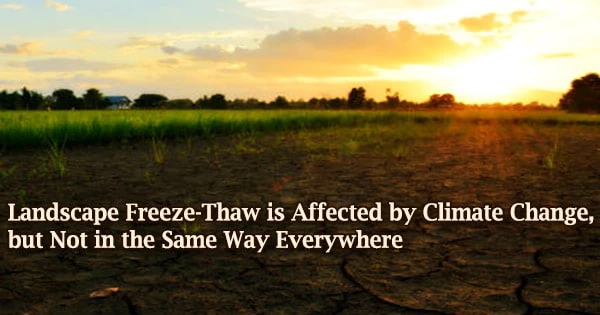A seasonal thaw is never easy, as everyone who lives in a northern environment knows. The freeze-thaw cycle can span months and has been moderated in the past by predictable air temperature and snow cover depth.
Climate change, on the other hand, warms the air and thins the snow, affecting this cycle. According to a new study published in the Nature journal Scientific Reports by Concordia researchers, this could have significant implications for greenhouse gas emissions in the north and urban infrastructure in the south.
Using a new statistical framework and datasets from the National Snow and Ice Data Center, Princeton University, and the Canadian Meteorological Centre in Dorval, Quebec, the researchers show how rising air temperatures and decreasing snow cover work together to amplify the effects of climate change in a non-linear way.
Furthermore, they have varying effects on Quebec’s various biological zones, posing distinctive challenges to policymakers and citizens.
“The historical data shows there is a vivid divide between Quebec’s northern areas and the southern parts of the province, where the majority of Quebec’s population and assets reside,” says Ali Nazemi, an associate professor in Concordia’s Department of Building, Civil and Environmental Engineering, and the principal investigator of the project and co-author of the paper.
Shadi Hatami, PhD 21, a Concordia graduate and current postdoctoral scholar at McGill, is the paper’s principal author
Compounding problems
Air temperature, snow cover, and freeze-thaw cycles are all linked, according to the study. In the winter, a thick layer of snow acts as a blanket for frozen earth. Warmer air penetrates the ground when the snow cover reduces, and thaws occur early.
By calculating these non-linear responses, we can try to quantify how many fewer frozen days we will see in the north and how many more transitional days we will see in the south under changes in temperature and snow depth conditions. This provides us with a way to approximate how many more tons of gases will be released into the atmosphere and how much more deterioration of our infrastructure we can expect.
Ali Nazemi
Such changes result in fewer days of frozen soil in the province’s far north, increasing the risk of the release of thousands of tons of greenhouse gases like carbon and methane into the sky.
These added gases will act to intensify the effects of climate change.
There will be more transitional days during the winter season in the more densely populated areas of the St. Lawrence river basin, when the soil undergoes a thaw and a freeze, with water repeatedly expanding and contracting as temperatures rise and fall. This will put further burden on already-fragile road, bridge, and water systems.
“By calculating these non-linear responses, we can try to quantify how many fewer frozen days we will see in the north and how many more transitional days we will see in the south under changes in temperature and snow depth conditions,” says Nazemi.
“This provides us with a way to approximate how many more tons of gases will be released into the atmosphere and how much more deterioration of our infrastructure we can expect.”
A quick reversion is also possible
The authors note out that, just as rising temperatures and decreased snow cover lead to increased thawing across the province’s ecological zones, the opposite is also true, albeit with less severity than warming.
Lower air temperatures and higher snow cover can actually accelerate freezing and recovery, bringing the number of frozen days in the north and the number of transitional days in the south closer to the historical norm.
The paper’s strength, according to Nazemi, is due to its strong mathematics and the large amount of data made available through diverse technologies such as satellite remote sensing.
Many prior studies have anticipated an increase in greenhouse gas emissions as a result of thawing permafrost, but these were frequently based on attempts to reproduce the physics of the event in tiny areas with numerous assumptions.
The new method is based on data collected from 25km × 25km scale pixels across Quebec’s area, as well as probability theory and statistical functions.
“We brought this newer mathematical analysis to quantify some factors that had not been quantified before,” he says. “We are now in the process of upscaling this methodology to cover the entire area of Canada and Alaska.”





